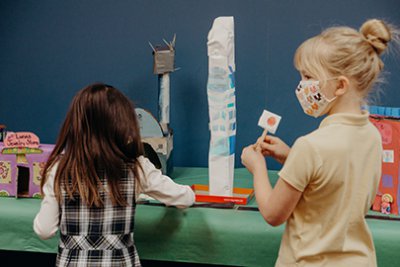March 4, 2021
 by Dr. Bill Hudson, Head of School
by Dr. Bill Hudson, Head of School
Educators are infamous for creating esoteric terms and anachronyms to describe different approaches to teaching and learning. Project-based learning, or PBL, is one such term but should not be confused with problem-based learning, also PBL. Both PBLs are similar, yet different. Debate exists within educational circles as to whether Design Thinking is a more inclusive term for both PBLs. To further complicate matters, some educators prefer the term “inquiry-based learning”. Confused? Ambivalent? Let me try to translate.
Whether described as project, problem, or inquiry-based learning, this form of learning has roots in what John Dewey (American philosopher, psychologist, and educational reformer who is often referred to as one of the “fathers of American education”) called “progressive education.” Contemporary educational theorists refer to it as a pedagogy (another educational esoteric term that designates an educational method) that “engages students in creating, questioning, and revising knowledge, while developing their skills in critical thinking, collaboration, communication, reasoning, synthesis, and resilience” (Barron & Darling-Hammond, 2008).
At MPA, we simply call it good teaching and learning, and it has been our foundational pedagogy since 1982. Over the years, we’ve used a variety of terms such as “hands-on, experiential learning,” “learning by doing,” “learning how, not what, to think,” or “rigor with purpose.” What’s important to know is that project-based learning is grounded in evidence-based research, demonstrated through good practice, and reflective of 21st century skills.
In the past week, there have been two excellent examples that illustrate our unique approach to project-based learning. The first-grade class is currently immersed in a social studies unit on “Communities and Mapping.” As Ms. O’Keefe describes it, “Students are learning about what makes up a community and the importance of maps. They began by brainstorming the many buildings and people that make up various communities. Students then looked at how the buildings might be laid out to make a community work and how to read maps with the use of a key and compass rose.”
The culminating activities involve the students planning and drawing out a 2-dimensional community and creating a 3-dimensional model of a community. Each student made a building for the 3-D community and is working together to manage the lay out (with focus on urban, suburban, and rural areas) and add additional elements to the model. The project also ties in geometry concepts in math, creative writing in language arts, and skill building in the Makerspace.
In the Upper School, students are taking their place in MPA lore by building bridges in Physics. This manifestation of project-based learning has been in place for 25 years and is often one of the first memories alumni recall when they gather. By building upon core physics content knowledge of motion and forces, students have the opportunity to apply their knowledge to structural analysis. Physics teacher Marc Shapiro puts it this way: “Like most engineering tasks, the open-ended nature of this project requires students to develop and evaluate potential solutions. Some students, who struggle with day-to-day lab work and calculations, thrive when given the chance to demonstrate knowledge in this new way. More than any other work in the Physics course, the bridge project allows students to unleash their creativity.”
These are just two of the countless examples of project-based learning across MPA grade levels, divisions, and disciplines. It provides students with the autonomy and agency to not only master content knowledge but find deeper meaning and significance, all while making connections across multiple and seemingly disparate areas. Now more than ever, our unique pedagogy is crucial to preparing students to live, learn, and thrive in today’s complex globalized society.